Propagation Dynamics from Meteorological to Agricultural Drought in Northwestern China: Key Influencing Factors
Abstract
:1. Introduction
2. Study Area and Data
3. Methodology
3.1. Standardized Drought Index
3.2. Three-Dimensional Clustering Method
3.3. Cross-Wavelet Transform
3.4. Wavelet Cross-Correlation
3.5. Grey Relational Analysis
4. Results
4.1. Spatiotemporal Patterns of Meteorological and Agricultural Droughts
4.2. Propagation Time from Meteorological Drought to Agricultural Drought
4.3. Multi-Timescale Linkages between Meteorological and Agricultural Droughts
4.4. Wavelet Cross-Correlation between Meteorological and Agricultural Droughts
5. Discussion
5.1. Lag Effects on Drought Propagation
5.2. Influencing Factors on Drought Propagation
6. Conclusions
Supplementary Materials
Author Contributions
Funding
Data Availability Statement
Conflicts of Interest
References
- Li, H.; Wang, H.; Sui, H.; Wardlow, B.; Hayes, M.; Wang, J. Mapping the Spatial-Temporal Dynamics of Vegetation Response Lag to Drought in a Semi-Arid Region. Remote Sens. 2019, 11, 1873. [Google Scholar] [CrossRef]
- Zhang, T.; Su, X.; Zhang, G.; Wu, H.; Wang, G.; Chu, J. Evaluation of the impacts of human activities on propagation from meteorological drought to hydrological drought in the Weihe River Basin, China. Sci. Total Environ. 2022, 819, 153030. [Google Scholar] [CrossRef] [PubMed]
- Wang, T.; Tu, X.; Singh, V.; Chen, X.; Lin, K. Global data assessment and analysis of drought characteristics based on CMIP6. J. Hydrol. 2021, 596, 126091. [Google Scholar] [CrossRef]
- Samantaray, A.K.; Ramadas, M.; Panda, R.K. Changes in drought characteristics based on rainfall pattern drought index and the CMIP6 multi-model ensemble. Agr. Water Manag. 2022, 266, S606841849. [Google Scholar] [CrossRef]
- Guo, W.; Huang, S.; Huang, Q.; Leng, G.; Mu, Z.; Han, Z.; Wei, X.; She, D.; Wang, H.; Wang, Z. Drought trigger thresholds for different levels of vegetation loss in China and their dynamics. Agr. Forest Meteorol. 2023, 331, 109349. [Google Scholar] [CrossRef]
- Mishra, A.K.; Singh, V.P. A review of drought concepts. J. Hydrol. 2010, 391, 202–216. [Google Scholar] [CrossRef]
- Zhu, H.; Chen, K.; Hu, S.; Liu, J.; Shi, H.; Wei, G.; Chai, H.; Li, J.; Wang, T. Using the Global Navigation Satellite System and Precipitation Data to Establish the Propagation Characteristics of Meteorological and Hydrological Drought in Yunnan, China. Water Resour. Res. 2023, 59, e2022WR033126. [Google Scholar] [CrossRef]
- Sadiqi, S.S.J.; Hong, E.M.; Nam, W.H.; Kim, T. Review: An integrated framework for understanding ecological drought and drought resistance. Sci. Total Environ. 2022, 846, 157477. [Google Scholar] [CrossRef]
- Xu, Y.; Zhang, X.; Wang, X.; Hao, Z.; Singh, V.P.; Hao, F. Propagation from meteorological drought to hydrological drought under the impact of human activities: A case study in northern China. J. Hydrol. 2019, 579, 124147. [Google Scholar] [CrossRef]
- Zhou, K.; Li, J.; Zhang, T.; Kang, A. The use of combined soil moisture data to characterize agricultural drought conditions and the relationship among different drought types in China. Agr. Water Manag. 2021, 243, 106479. [Google Scholar] [CrossRef]
- Gevaert, A.; Veldkamp, T.I.E.; Ward, P. The effect of climate type on timescales of drought propagation in an ensemble of global hydrological models. Hydrol. Earth Syst. Sci. 2018, 22, 4649–4665. [Google Scholar] [CrossRef]
- Shi, H.; Chen, J.; Wang, K.; Niu, J. A new method and a new index for identifying socioeconomic drought events under climate change: A case study of the East River basin in China. Sci. Total Environ. 2018, 616–617, 363–375. [Google Scholar] [CrossRef] [PubMed]
- Sun, H.; Sun, X.; Chen, J.; Deng, X.; Yang, Y.; Qin, H.; Chen, F.; Zhang, W. Different types of meteorological drought and their impact on agriculture in Central China. J. Hydrol. 2023, 627, 130423. [Google Scholar] [CrossRef]
- Fang, W.; Huang, S.; Huang, Q.; Huang, G.; Wang, H.; Leng, G.; Wang, L. Identifying drought propagation by simultaneously considering linear and nonlinear dependence in the Wei River basin of the Loess Plateau, China. J. Hydrol. 2020, 591, 125287. [Google Scholar] [CrossRef]
- Wang, Z.; Chang, J.; Wang, Y.; Yang, Y.; Guo, Y.; Yang, G.; He, B. Temporal and spatial propagation characteristics of meteorological drought to hydrological drought and influencing factors. Atmos. Res. 2024, 299, 107212. [Google Scholar] [CrossRef]
- Han, Z.; Huang, S.; Zhao, J.; Leng, G.; Huang, Q.; Zhang, H.; Li, Z. Long-chain propagation pathways from meteorological to hydrological, agricultural and groundwater drought and their dynamics in China. J. Hydrol. 2023, 625, 130131. [Google Scholar] [CrossRef]
- Yang, F.; Xingwu, D.; Guo, Q.; Lu, S.; Hsu, K. The spatiotemporal variations and propagation of droughts in Plateau Mountains of China. Sci. Total Environ. 2021, 805, 150257. [Google Scholar] [CrossRef]
- Geng, G.; Zhang, B.; Gu, Q.; He, Z.; Zheng, R. Drought propagation characteristics across China: Time, probability, and threshold. J. Hydrol. 2024, 631, 130805. [Google Scholar] [CrossRef]
- Wang, F.; Wang, Z.; Yang, H.; Di, D.; Zhao, Y.; Liang, Q.; Hussain, Z. Comprehensive evaluation of hydrological drought and its relationships with meteorological drought in the Yellow River basin. China. J. Hydrol. 2020, 584, 124751. [Google Scholar] [CrossRef]
- Zhu, Y.; Liu, Y.; Wang, W.; Singh, V.P.; Ma, X.; Yu, Z. Three dimensional characterization of meteorological and hydrological droughts and their probabilistic links. J. Hydrol. 2019, 578, 124016. [Google Scholar] [CrossRef]
- Lin, Q.; Wu, Z.; Zhang, Y.; Peng, T.; Chang, W.; Guo, J. Propagation from meteorological to hydrological drought and its application to drought prediction in the Xijiang River basin, South China. J. Hydrol. 2022, 617, 128889. [Google Scholar] [CrossRef]
- Xu, Y.; Zhang, X.; Hao, Z.; Singh, V.P.; Hao, F. Characterization of agricultural drought propagation over China based on bivariate probabilistic quantification. J. Hydrol. 2021, 598, 126194. [Google Scholar] [CrossRef]
- Han, Z.; Huang, S.; Huang, Q.; Leng, G.; Liu, Y.; Bai, Q.; He, P.; Liang, H.; Shi, W. GRACE-based high-resolution propagation threshold from meteorological to groundwater drought. Agr. Forest Meteorol. 2021, 307, 108476. [Google Scholar] [CrossRef]
- Wang, X.; Zhang, B.; Zhang, Z.; Tian, L.; Kunstmann, H.; He, C. Identifying spatiotemporal propagation of droughts in the agro-pastoral ecotone of northern China with long-term WRF simulations. Agr. Forest Meteorol. 2023, 336, 109474. [Google Scholar] [CrossRef]
- Sun, P.; Liu, R.; Yao, R.; Hao, S.; Bian, Y. Responses of agricultural drought to meteorological drought under different climatic zones and vegetation types. J. Hydrol. 2023, 619, 129305. [Google Scholar] [CrossRef]
- Cao, S.; Zhang, L.; He, Y.; Zhang, Y.; Chen, Y.; Yao, S.; Yang, W.; Sun, Q. Effects and contributions of meteorological drought on agricultural drought under different climatic zones and vegetation types in Northwest China. Sci. Total Environ. 2022, 821, 153270. [Google Scholar] [CrossRef] [PubMed]
- Zhou, J.; Li, Q.; Wang, L.; Lei, L.; Huang, M.; Xiang, J.; Feng, W.; Zhao, Y.; Xue, D.; Liu, C.; et al. Impact of Climate Change and Land-Use on the Propagation from Meteorological Drought to Hydrological Drought in the Eastern Qilian Mountains. Water. 2019, 11, 1602. [Google Scholar] [CrossRef]
- Cao, S.; He, Y.; Zhang, L.; Chen, Y.; Yang, W.; Yao, S.; Sun, Q. Spatiotemporal characteristics of drought and its impact on vegetation in the vegetation region of Northwest China. Ecol. Indic. 2021, 133, 108420. [Google Scholar] [CrossRef]
- Han, Z.; Zhang, B.; Yang, L.; He, C. Assessment of the impact of future climate change on maize yield and water use efficiency in agro-pastoral ecotone of Northwestern China. J. Agron. Crop Sci. 2021, 207, 317–331. [Google Scholar] [CrossRef]
- Feng, K.; Yan, Z.; Li, Y.; Wang, F.; Zhang, Z.; Su, X.; Wu, H.; Zhang, G.; Wang, Y. Spatio-temporal dynamic evaluation of agricultural drought based on a three-dimensional identification method in Northwest China. Agr. Water Manag. 2023, 284, 108325. [Google Scholar] [CrossRef]
- Gao, S.; Lai, H.; Wang, F.; Qiang, X.; Li, H.; Di, D. An Analysis of Spatial–Temporal Evolution and Propagation Features of Vegetation Drought in Different Sub-Zones of China. Agronomy 2023, 13, 2101. [Google Scholar] [CrossRef]
- Yang, G.; Chang, J.; Wang, Y.; Guo, A.; Zhang, L.; Zhou, K.; Wang, Z. Understanding drought propagation through coupling spatiotemporal features using vine copulas: A compound drought perspective. Sci. Total Environ. 2024, 921, 171080. [Google Scholar] [CrossRef] [PubMed]
- Chen, X.; Li, F.W.; Li, J.Z.; Feng, P. Three-dimensional identification of hydrological drought and multivariate drought risk probability assessment in the Luanhe River basin, China. Theor. Appl. Climatol. 2019, 137, 3055–3076. [Google Scholar] [CrossRef]
- Luo, M.; Lau, N.-C.; Liu, Z.; Wu, S.; Wang, X. An Observational Investigation of Spatiotemporally Contiguous Heatwaves in China From a 3D Perspective. Geophys. Res. Lett. 2022, 49, e2022GL097714. [Google Scholar] [CrossRef]
- Meng, C.; Dong, Z.; Liu, K.; Wang, Y.; Zhang, Y.; Zhu, Y. Identification and analysis of evolution characteristics of flash drought based on three-dimensional perspective: A case study in the Jialing River basin. Urban Clim. 2024, 53, 101803. [Google Scholar] [CrossRef]
- Ji, Y.; Fu, J.; Lu, Y.; Liu, B. Three-dimensional-based global drought projection under global warming tendency. Atmos. Res. 2023, 291, 106812. [Google Scholar] [CrossRef]
- Feng, K.; Su, X.; Singh, V.P.; Ayantobo, O.O.; Zhang, G.; Wu, H.; Zhang, Z. Dynamic evolution and frequency analysis of hydrological drought from a three-dimensional perspective. J. Hydrol. 2021, 600, 126675. [Google Scholar] [CrossRef]
- Han, Z.; Huang, S.; Huang, Q.; Leng, G.; Wang, H.; Bai, Q.; Zhao, J.; Ma, L.; Wang, L.; Du, M. Propagation dynamics from meteorological to groundwater drought and their possible influence factors. J. Hydrol. 2019, 578, 124102. [Google Scholar] [CrossRef]
- Lin, Q.; Wu, Z.; Singh, V.P.; Sadeghi, S.H.R.; He, H.; Lu, G. Correlation between hydrological drought, climatic factors, reservoir operation, and vegetation cover in the Xijiang Basin, South China. J. Hydrol. 2017, 549, 512–524. [Google Scholar] [CrossRef]
- Li, Q.; He, P.; He, Y.; Han, X.; Zeng, T.; Lu, G.; Wang, H. Investigation to the relation between meteorological drought and hydrological drought in the upper Shaying River Basin using wavelet analysis. Atmos. Res. 2020, 234, 104743. [Google Scholar] [CrossRef]
- Yang, P.; Zhai, X.; Huang, H.; Zhang, Y.; Zhu, Y.; Shi, X.; Zhou, L.; Fu, C. Association and driving factors of meteorological drought and agricultural drought in Ningxia, Northwest China. Atmos. Res. 2023, 289, 106753. [Google Scholar] [CrossRef]
- Potopová, V.; Štěpánek, P.; Možný, M.; Türkott, L.; Soukup, J. Performance of the standardised precipitation evapotranspiration index at various lags for agricultural drought risk assessment in the Czech Republic. Agr. Forest Meteorol. 2015, 202, 26–38. [Google Scholar] [CrossRef]
- Feng, K.; Su, X.; Zhang, G.; Javed, T.; Zhang, Z. Development of a new integrated hydrological drought index (SRGI) and its application in the Heihe River Basin, China. Theor. Appl. Climatol. 2020, 141, 43–59. [Google Scholar] [CrossRef]
- Zhan, C.; Liang, C.; Zhao, L.; Jiang, S.; Niu, K.; Zhang, Y. Drought-related cumulative and time-lag effects on vegetation dynamics across the Yellow River Basin, China. Ecol. Indic. 2022, 143, 109409. [Google Scholar] [CrossRef]
- Lin, H.; Yu, Z.; Chen, X.; Gu, H.; Ju, Q.; Shen, T. Spatial-temporal dynamics of meteorological and soil moisture drought on the Tibetan Plateau: Trend, response, and propagation process. J. Hydrol. 2023, 626, 130211. [Google Scholar] [CrossRef]
- Yang, Y.; Shang, S.; Jiang, L. Remote sensing temporal and spatial patterns of evapotranspiration and the responses to water management in a large irrigation district of North China. Agr. Forest Meteorol. 2012, 164, 112–122. [Google Scholar] [CrossRef]
- Faiz, M.A.; Zhang, Y.Q.; Tian, X.Q.; Zhang, X.Z.; Ma, N.; Aryal, S. Time series analysis for droughts characteristics response to propagation. Int. J. Climatol. 2023, 43, 1561–1575. [Google Scholar] [CrossRef]
- Huang, S.; Li, P.; Huang, Q.; Leng, G.; Hou, B.; Ma, L. The propagation from meteorological to hydrological drought and its potential influence factors. J. Hydrol. 2017, 547, 184–195. [Google Scholar] [CrossRef]
- Qi, W.; Feng, L.; Liu, J.; Yang, H. Snow as an important natural reservoir for runoff and soil moisture in Northeast China. J. Geophys. Res. Atmos. 2020, 125, e2020JD033086. [Google Scholar] [CrossRef]
- Zhang, H.; Ding, J.; Wang, Y.S.; Zhou, D.Y.; Zhu, Q. Investigation about the correlation and propagation among meteorological, agricultural and groundwater droughts over humid and arid/semi-arid basins in China. J. Hydrol. 2021, 603, 127007. [Google Scholar] [CrossRef]
- Huang, S.Z.; Huang, Q.; Chang, J.X.; Leng, G.Y.; Xing, L. The response of Agricultural drought to Meteorological drought and the influencing factors: A case study in the Wei River Basin, China. Agric. Water Manag. 2015, 159, 45–54. [Google Scholar] [CrossRef]
- Yang, Y.; McVicar, T.; Donohue, R.; Zhang, Y.; Roderick, M.; Chiew, F.; Zhang, L.; Zhang, J. Lags in hydrologic recovery following an extreme drought: Assessing the roles of climate and catchment characteristics. Water Resour. Res. 2017, 53, 4821–4837. [Google Scholar] [CrossRef]
- Wu, Z.; Feng, H.; He, H.; Zhou, J.; Zhang, Y. Evaluation of soil moisture climatology and anomaly components derived from ERA5-land and GLDAS-2.1 in China. Water Resour. Manag. 2021, 35, 629–643. [Google Scholar] [CrossRef]
- Fuentes, I.; Padarian, J.; Vervoort, R.W. Spatial and temporal global patterns of drought propagation. Front. Environ. Sci. 2022, 10, 21. [Google Scholar] [CrossRef]
- Zhu, Y.; Yang, P.; Xia, J.; Huang, H.; Chen, Y.; Li, Z.; Sun, K.; Song, J.; Shi, X.; Lu, X. Drought propagation and its driving forces in central Asia under climate change. J. Hydrol. 2024, 636, 131260. [Google Scholar] [CrossRef]
- Hope, A.; Fouad, G.; Granovskaya, Y. Evaluating drought response of Southern Cape Indigenous Forests, South Africa, using MODIS data. Int. J. Remote Sens. 2014, 35, 4852–4864. [Google Scholar] [CrossRef]
- Sterling, S.; Ducharne, A.; Polcher, J. The impact of global land-cover change on the terrestrial water cycle. Nat. Clim. Chang. 2013, 3, 13688. [Google Scholar] [CrossRef]
- Zhang, X.; Hao, Z.; Singh, V.P.; Zhang, Y.; Feng, S.; Xu, Y.; Hao, F. Drought propagation under global warming: Characteristics, approaches, processes, and controlling factors. Sci. Total Environ. 2022, 838, 156021. [Google Scholar] [CrossRef]
- Zhao, W.; Wu, J.; Du, E.; Deng, X.; Sun, G.; Wang, G. Deciphering the influence of climate change and human activities on the drought propagation. J. Hydrol.-Reg. Stud. 2024, 51, 101654. [Google Scholar] [CrossRef]
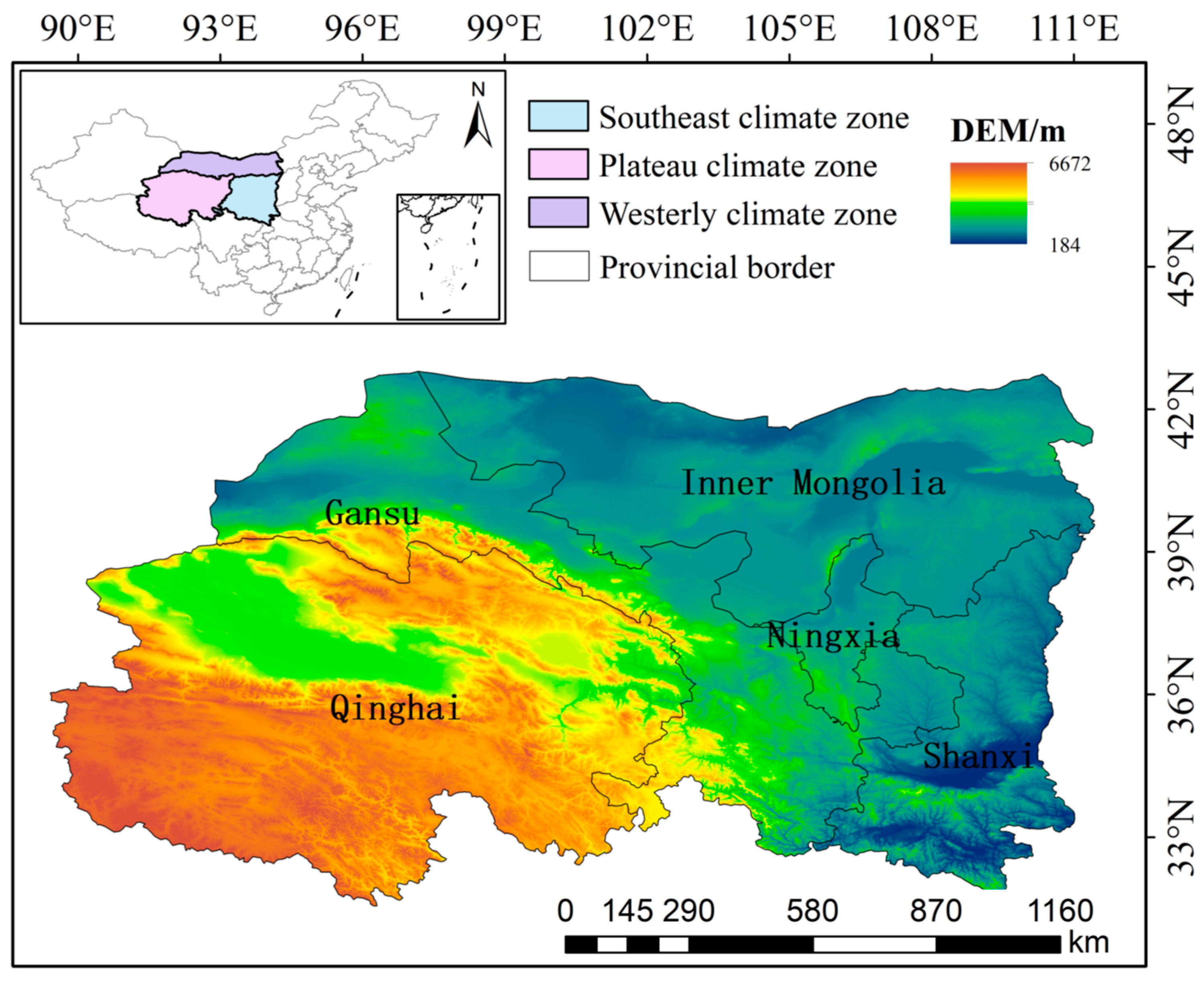
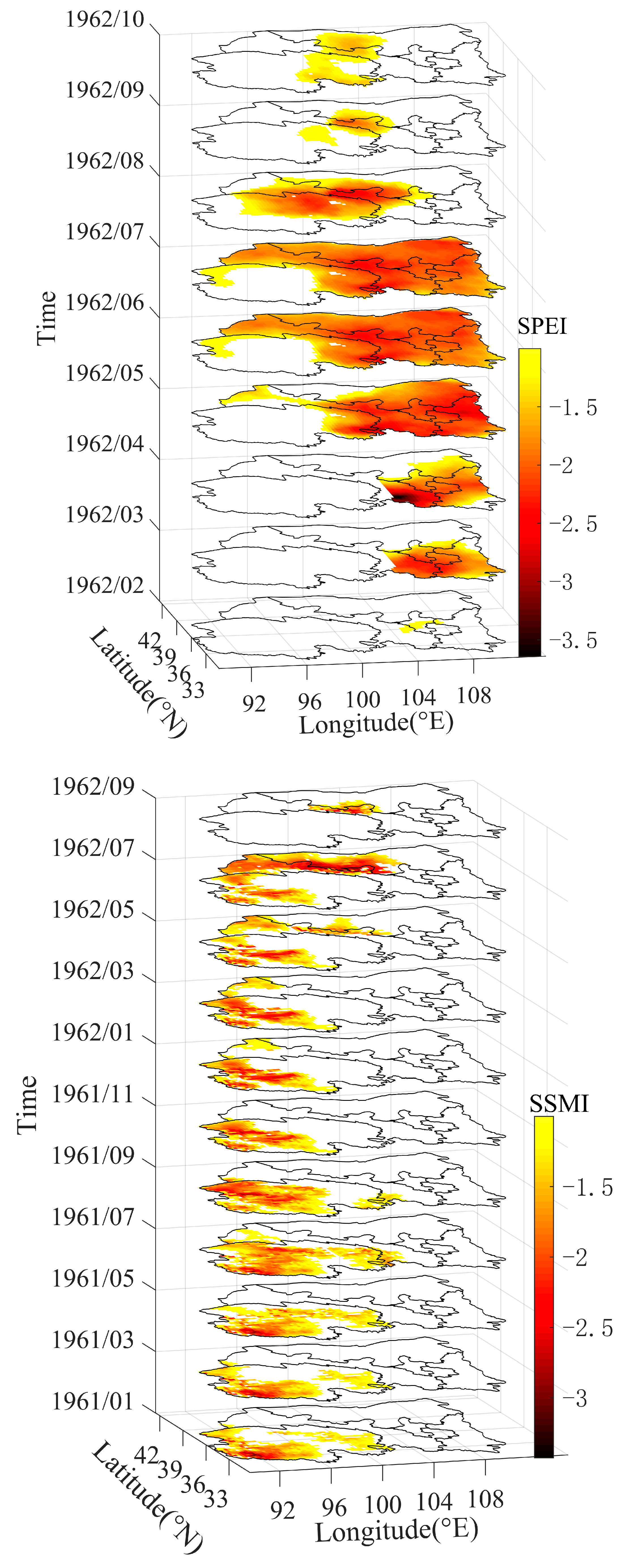
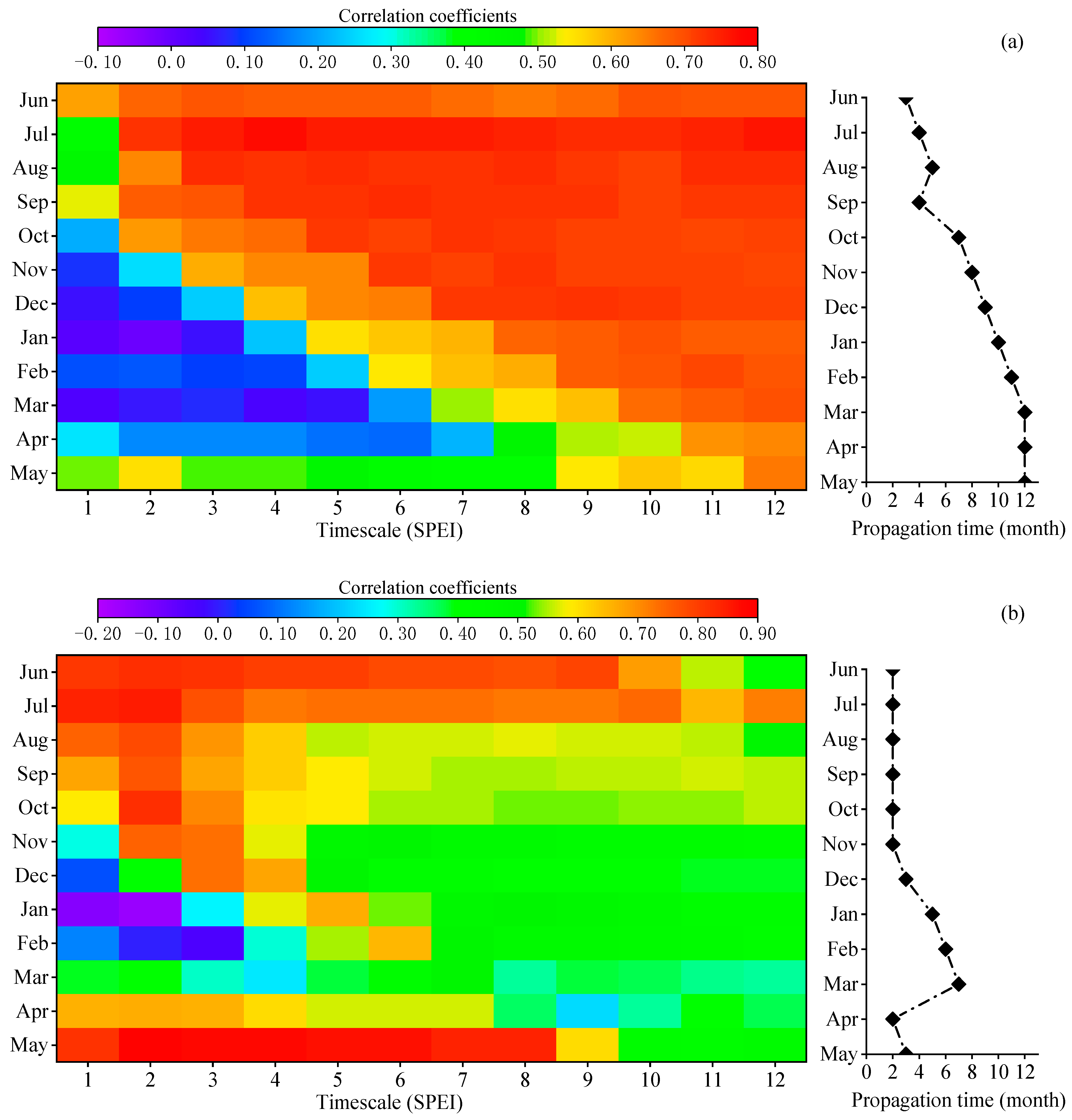
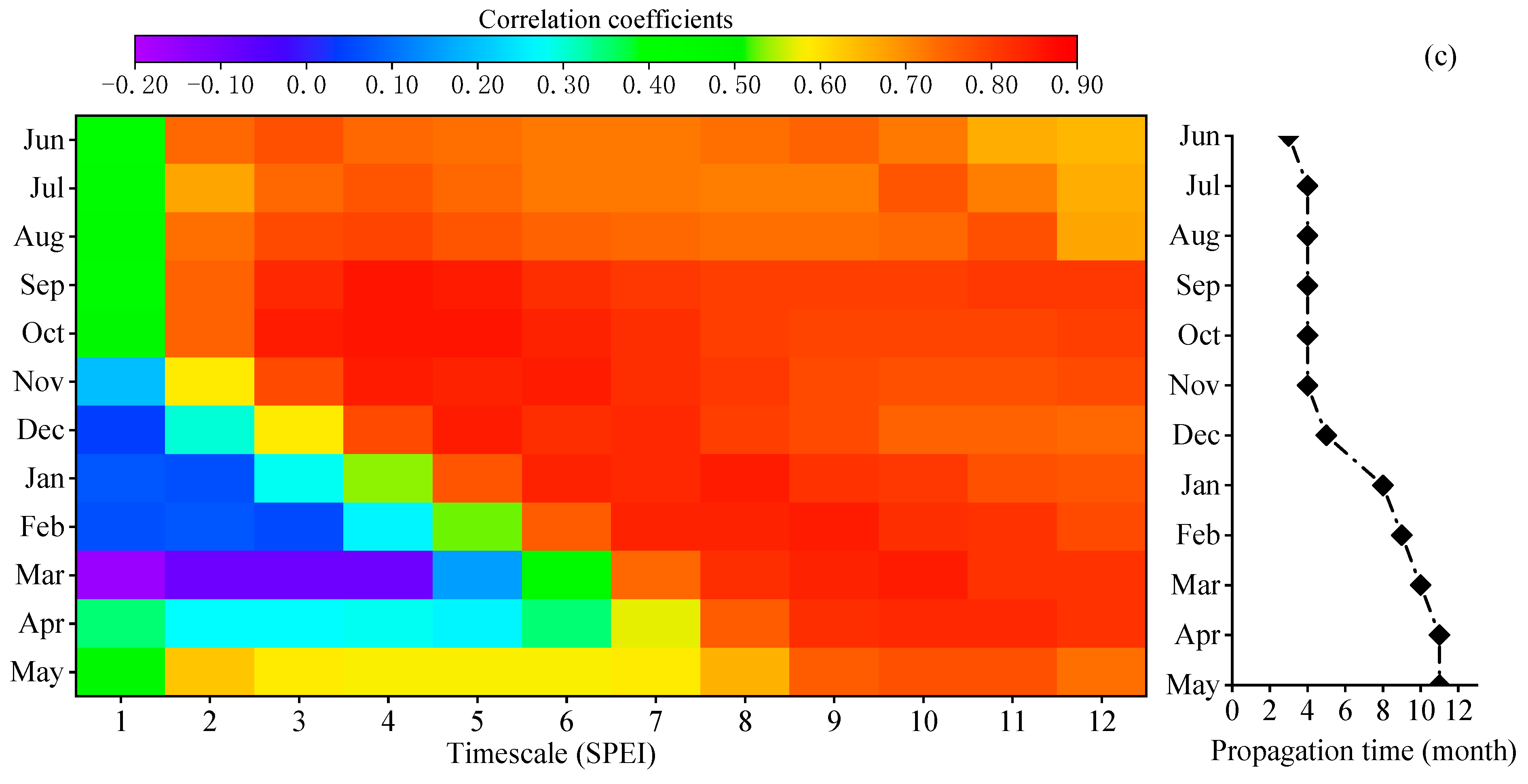
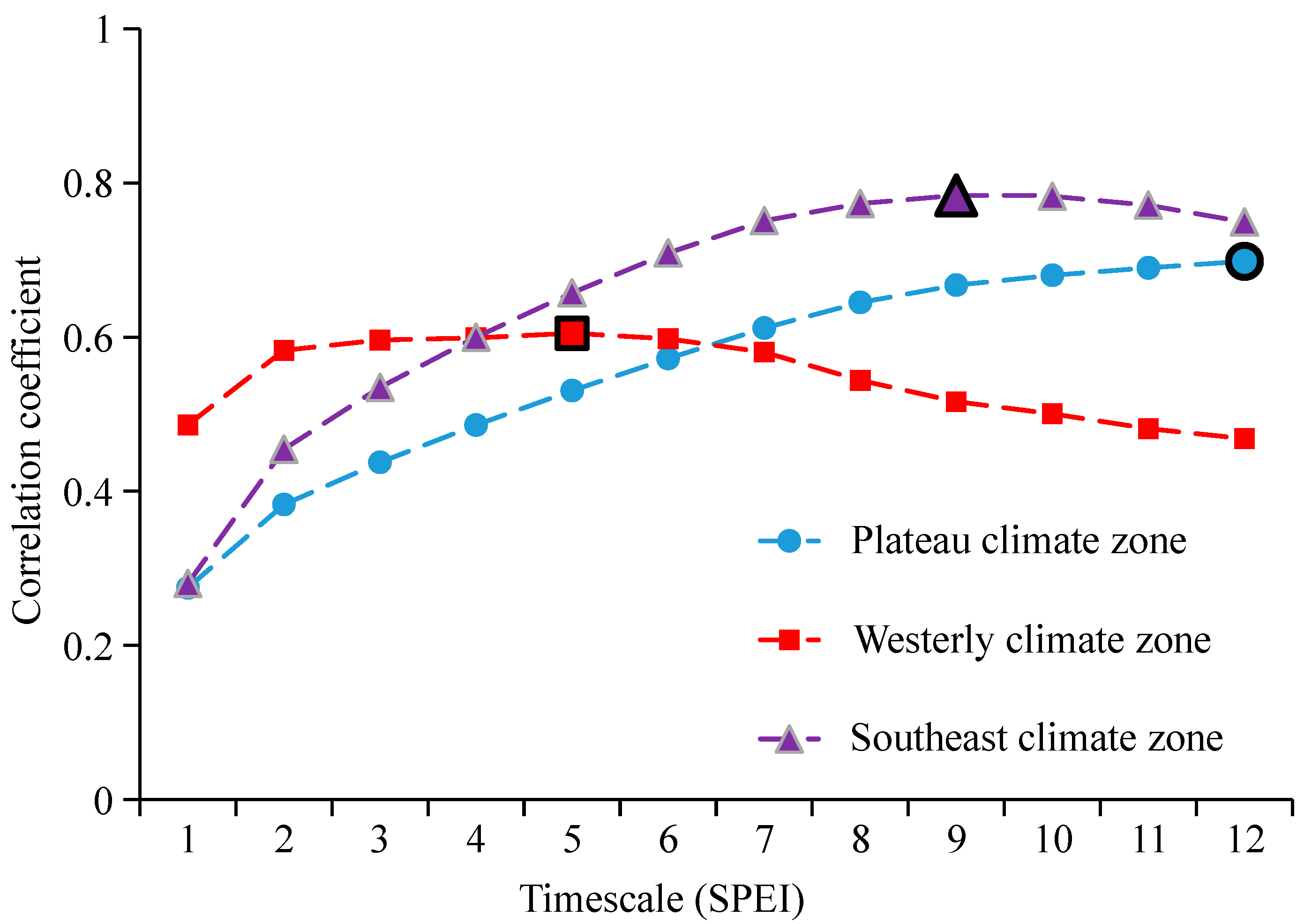


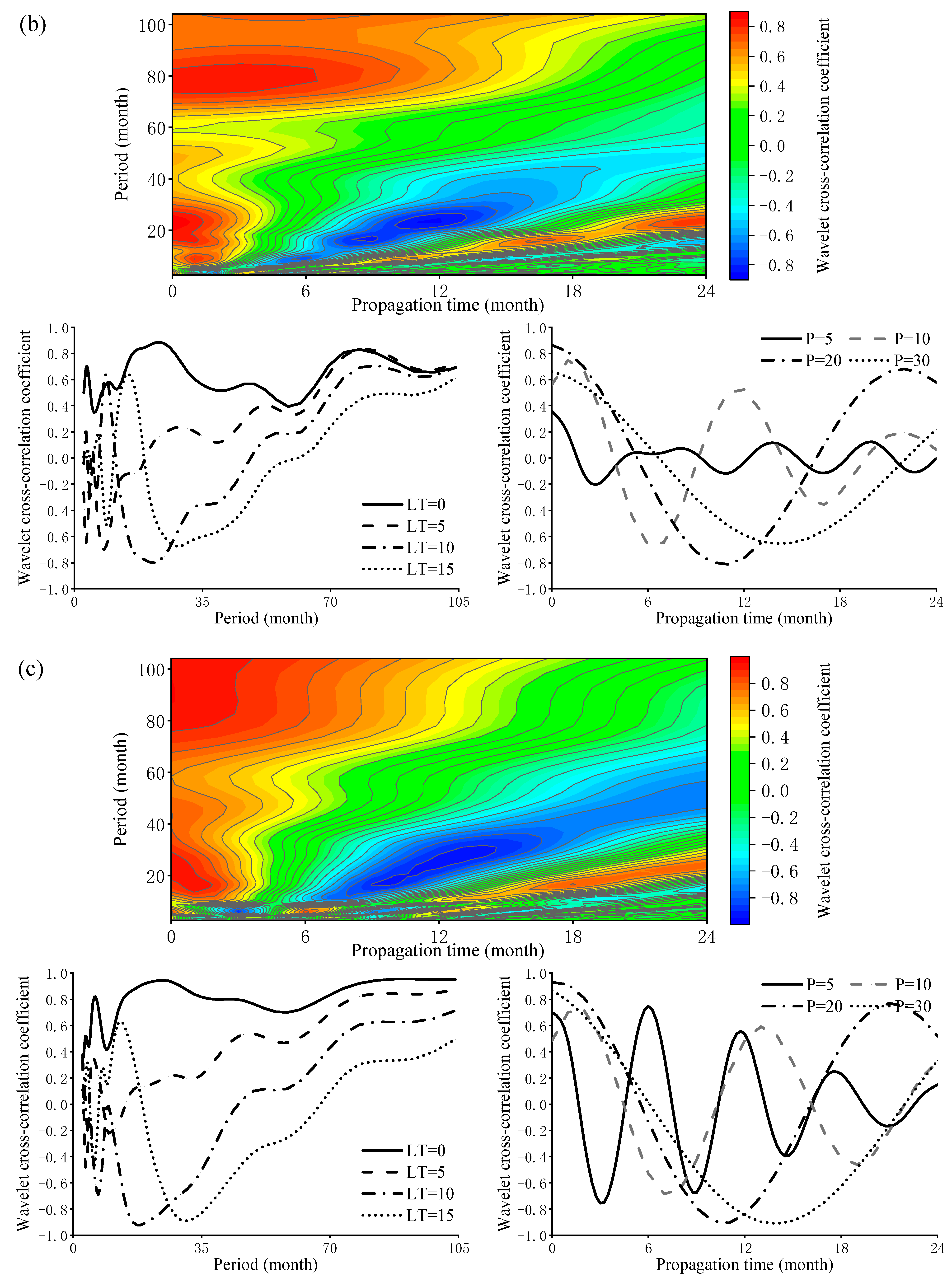

| Drought Level | SPEI/SSMI | Class |
|---|---|---|
| I | −0.5 < SPEI and SSMI | No drought |
| II | −1.0 < SPEI and SSMI ≤ −0.5 | Mild drought |
| III | −1.5 < SPEI and SSMI ≤ −1.0 | Moderate drought |
| IV | −2.0 < SPEI and SSMI ≤ −1.5 | Severe drought |
| V | SPEI and SSMI ≤ −2 | Extreme drought |
| Drought Variable | Meteorological Drought | Agricultural Drought | |||||||||||
|---|---|---|---|---|---|---|---|---|---|---|---|---|---|
| 1960s | 1970s | 1980s | 1990s | 2000s | 2010s | 1960s | 1970s | 1980s | 1990s | 2000s | 2010s | ||
| Number of events | 50 | 64 | 58 | 54 | 66 | 52 | 23 | 30 | 33 | 33 | 17 | 33 | |
| Drought duration (month) | Mean | 2.66 | 2.58 | 2.26 | 2.30 | 1.92 | 2.21 | 7 | 5 | 5.27 | 6.24 | 5 | 4.82 |
| Max | 9 | 11 | 11 | 8 | 8 | 9 | 22 | 26 | 21 | 24 | 17 | 21 | |
| SD | 2.26 | 2.30 | 2.07 | 1.84 | 1.55 | 1.67 | 6.41 | 6.24 | 4.81 | 5.72 | 4.30 | 4.99 | |
| Proportion for ≥2 | 52.0% | 48.4% | 41.4% | 46.3% | 39.4% | 51.9% | 81.8% | 70% | 86.7% | 69.7% | 82.4% | 66.7% | |
| Drought area (106 km2) | Mean | 0.34 | 0.30 | 0.31 | 0.33 | 0.22 | 0.29 | 0.21 | 0.11 | 0.14 | 0.14 | 0.16 | 0.11 |
| Max | 1.54 | 1.49 | 1.62 | 1.61 | 1.33 | 1.61 | 1.03 | 0.35 | 0.55 | 0.73 | 0.82 | 0.45 | |
| SD | 0.38 | 0.31 | 0.39 | 0.35 | 0.26 | 0.32 | 0.26 | 0.09 | 0.15 | 0.17 | 0.19 | 0.10 | |
| Drought severity (106 month·km2) | Mean | 1.21 | 0.77 | 0.90 | 0.98 | 0.53 | 0.71 | 1.82 | 0.59 | 0.87 | 1.13 | 0.76 | 0.66 |
| Max | 9.38 | 6.81 | 7.31 | 8.53 | 7.15 | 5.41 | 12.98 | 4.54 | 6.09 | 8.21 | 4.16 | 4.19 | |
| Min | 0.04 | 0.04 | 0.03 | 0.03 | 0.03 | 0.03 | 0.03 | 0.03 | 0.04 | 0.04 | 0.03 | 0.04 | |
| SD | 2.04 | 1.16 | 1.62 | 1.72 | 1.07 | 1.11 | 3.17 | 0.99 | 1.57 | 2.00 | 1.06 | 0.99 | |
| Migration distance (km) | Mean | 259.28 | 282.64 | 243.33 | 234.56 | 189.14 | 258.13 | 341.45 | 159.58 | 195.35 | 244.19 | 217.42 | 212.86 |
| Max | 1763.71 | 2572.17 | 1685.60 | 1554.16 | 2115.55 | 1901.33 | 1955.27 | 965.70 | 1019.14 | 1188.27 | 1470.72 | 970.83 | |
| SD | 398.34 | 473.57 | 436.02 | 396.07 | 383.38 | 401.80 | 489.36 | 245.94 | 272.95 | 336.21 | 341.41 | 250.08 | |
| Sub-Regions | Influencing Factors | Spring | Summer | Autumn | Winter | ||||
|---|---|---|---|---|---|---|---|---|---|
| r | R | r | R | r | R | r | R | ||
| Plateau climate zone | Precipitation | 0.16 ** | 0.640 | 0.79 ** | 0.729 | 0.53 ** | 0.755 | 0.13 * | 0.655 |
| PET | −0.66 ** | 0.657 | −0.73 ** | 0.531 | −0.47 ** | 0.618 | −0.005 | 0.602 | |
| Soil moisture | 0.69 ** | 0.693 | 0.85 ** | 0.817 | 0.71 ** | 0.759 | 0.63 ** | 0.695 | |
| DEM | 0.55 ** | 0.630 | 0.47 ** | 0.641 | 0.57 ** | 0.641 | 0.64 ** | 0.638 | |
| Southeastern climate zone | Precipitation | −0.04 | 0.755 | −0.10 * | 0.624 | 0.37 ** | 0.749 | 0.26 ** | 0.826 |
| PET | −0.02 | 0.744 | 0.14 ** | 0.615 | −0.27 ** | 0.723 | 0.32 ** | 0.751 | |
| Soil moisture | 0.20 ** | 0.792 | 0.15 ** | 0.727 | 0.51 ** | 0.823 | 0.52 ** | 0.931 | |
| DEM | 0.09 * | 0.681 | 0.20 ** | 0.649 | 0.52 ** | 0.845 | 0.21 ** | 0.541 | |
| Westerly climate zone | Precipitation | 0.68 ** | 0.753 | 0.72 ** | 0.683 | 0.67 ** | 0.744 | 0.39 ** | 0.806 |
| PET | 0.09 * | 0.615 | −0.31 ** | 0.687 | 0.03 | 0.756 | 0.35 ** | 0.681 | |
| Soil moisture | 0.89 ** | 0.813 | 0.92 ** | 0.806 | 0.84 ** | 0.758 | 0.75 ** | 0.737 | |
| DEM | 0.10 * | 0.789 | 0.02 | 0.477 | 0.12 ** | 0.749 | 0.07 | 0.733 | |
Disclaimer/Publisher’s Note: The statements, opinions and data contained in all publications are solely those of the individual author(s) and contributor(s) and not of MDPI and/or the editor(s). MDPI and/or the editor(s) disclaim responsibility for any injury to people or property resulting from any ideas, methods, instructions or products referred to in the content. |
© 2024 by the authors. Licensee MDPI, Basel, Switzerland. This article is an open access article distributed under the terms and conditions of the Creative Commons Attribution (CC BY) license (https://creativecommons.org/licenses/by/4.0/).
Share and Cite
Feng, K.; Yuan, H.; Wang, Y.; Li, Y.; Wang, X.; Wang, F.; Su, X.; Zhang, Z. Propagation Dynamics from Meteorological to Agricultural Drought in Northwestern China: Key Influencing Factors. Agronomy 2024, 14, 1987. https://doi.org/10.3390/agronomy14091987
Feng K, Yuan H, Wang Y, Li Y, Wang X, Wang F, Su X, Zhang Z. Propagation Dynamics from Meteorological to Agricultural Drought in Northwestern China: Key Influencing Factors. Agronomy. 2024; 14(9):1987. https://doi.org/10.3390/agronomy14091987
Chicago/Turabian StyleFeng, Kai, Haobo Yuan, Yingying Wang, Yanbin Li, Xiaowan Wang, Fei Wang, Xiaoling Su, and Zezhong Zhang. 2024. "Propagation Dynamics from Meteorological to Agricultural Drought in Northwestern China: Key Influencing Factors" Agronomy 14, no. 9: 1987. https://doi.org/10.3390/agronomy14091987





